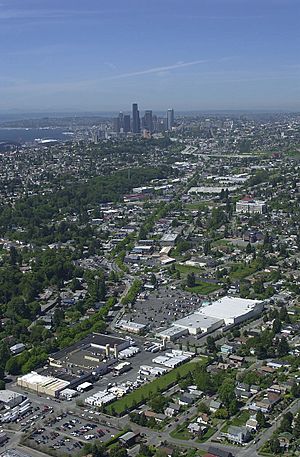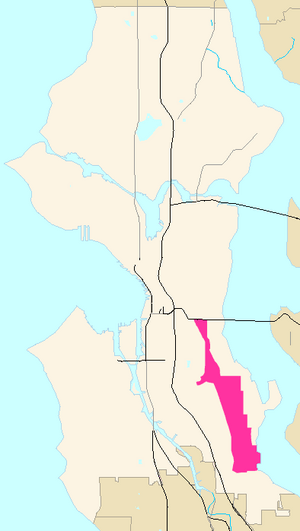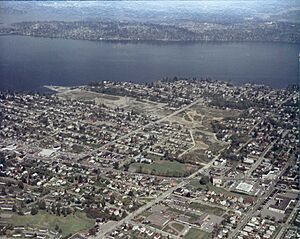Rainier Valley, Seattle facts for kids
Quick facts for kids
Rainier Valley
|
|
|---|---|
|
Neighborhood of Seattle
|
|

Aerial view of Rainier Valley, with downtown Seattle in the background, taken in 2001
|
|

Map of Seattle with the general boundaries of Rainier Valley highlighted
|
|
| Country | United States |
| State | Washington |
| County | King County |
| City | Seattle |
| Area code(s) | 206 |
The Rainier Valley is a neighborhood in southeast Seattle, Washington. It is located east of Beacon Hill and west of Mount Baker. It is also south of the Central District and north of Rainier Beach. This area is part of Seattle's South End.
Contents
Exploring Rainier Valley's Past
People from Europe started exploring and settling in the Rainier Valley area in the 1850s. An explorer named Issac Ebey mapped the area in 1850. His findings were shared in an Oregon newspaper to encourage more settlers to come. Before this, Native American tribes had several camps here. They also had a permanent village at the south end of the valley.
Early Settlers and Diversity
In the early 1900s, many Italian families lived in the northern part of the Valley. The central part was settled by people from northern Europe, like those from Britain and Scandinavia. Japanese farmers also lived in the Valley from the beginning. They started two important Japanese-American plant nurseries: Mizukis and Holly Park.
During World War II, two housing areas were built in the Valley. These were called Holly Park and Rainier Vista. The Seattle Housing Authority built them for people working at Boeing and in shipyards during the war. After the war, the Valley grew quickly. Many middle-class homes were built. This growth helped the Valley stay a very diverse place.
In the 1950s, couples from different backgrounds found the Valley more welcoming. This was because there were fewer "deed covenants" here. These were old rules that made it hard for different groups to live together. The U.S. Supreme Court later said these rules were against the law.
Changes and New Beginnings
After the Civil Rights Act in the 1960s, some families moved out of the valley. By the mid-1980s, some people who grew up in the Valley started to return. New residents also moved in. When the Vietnam War ended in 1975, many Vietnamese immigrants arrived. They opened businesses along Martin Luther King Jr. Way South. This area stretched for miles south of the official Little Saigon neighborhood.
More people from the Philippines also moved into the Valley. St. Edward Roman Catholic Church became an important cultural center for the Filipino community there.
Historic Growth and Homes
The neighborhoods along Rainier Avenue South are very old, just like other parts of Seattle. This is because a historic streetcar line ran there. In 1892, this streetcar connected downtown Seattle to Columbia City and later to Renton. It was known as the "Rainier Valley and Renton Railroad."
Changes to the Duwamish River and Lake Washington helped make the valley dry enough for building. The Valley grew rapidly during the Alaskan Gold Rush and up until the 1930s. Many homes built before World War II can be found throughout the Valley. These large homes often had big yards that were later divided and sold. For example, J. Walter Nordstrom, who started the famous Nordstrom stores, owned an estate here from 1902 to 1916. The Valley has a mix of old and newer homes. The area around Columbia City has mostly homes built before World War II.
Rainier Valley's Location and Layout
Rainier Valley has several smaller neighborhoods within it. From north to south, these include "Garlic Gulch" (or the north Valley), "Genesee," Columbia City, Hillman City, Brighton, Dunlap, and Rainier Beach. Rainier Beach is the only neighborhood in Seattle where Black Americans make up the majority of residents.
Main Roads and Transportation
The Valley is centered around Rainier Avenue South and Martin Luther King Jr. Way South. These are its main roads, running northwest and southeast. Both Rainier Avenue South and the Valley itself are named after Mount Rainier. The Valley faces the mountain, which is a unique geographic feature.
Rainier Avenue South changes as it goes towards Renton. The northern part is mostly for businesses. The central part, around Columbia City, is a busy historic area. The southern part has fewer businesses and more apartments and houses.
Martin Luther King Jr. Way South, often called "MLK Way," used to be known as Empire Way. It was renamed in the 1980s. Seattle's light rail line now runs along MLK Way through the Valley. The light rail and other improvements have brought new life to this area. New homes and businesses have been built near the light rail stations at Columbia City and Othello.
People and Cultures in Rainier Valley
Rainier Valley is one of the most diverse neighborhoods in the Pacific Northwest. It has many different cultures and people from various economic backgrounds. The neighborhood has a population of 34,241 people. Asians make up the largest group, with Filipinos being the biggest group within the Asian population. There are also many African American and European American residents.
The zip code for Rainier Valley is 98118. This zip code also includes Seward Park, which is just east of Rainier Valley. The area to the west, Beacon Hill, mostly uses zip code 98108. Sometimes, "Greater Rainier Valley" is used to include parts of Seward Park and Beacon Hill.
The population of Rainier Valley includes people from many different backgrounds. This mix of cultures makes the neighborhood a vibrant and interesting place to live.
Community Well-being
Since the 1960s, there have been efforts to improve the community in Rainier Valley. The area was home to two housing projects, Rainier Vista and Holly Park.
In 2006, the Seattle Police Department reported positive changes in the South Precinct, which includes Rainier Valley. The overall crime rate had decreased. This showed that community efforts were helping to make the area safer.
Rainier Valley's Economy
The neighborhood offers many places to buy food. You can find small delis, bakeries, and restaurants. These businesses add to the local economy and provide many choices for residents.


